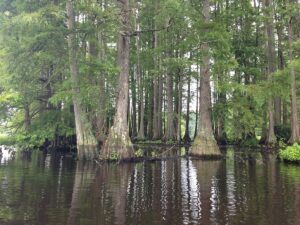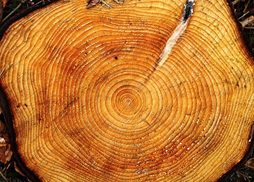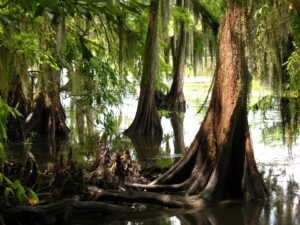In 2019 it was announced that North Carolina had placed on an unusual “top 10” list: World’s Oldest Living Trees. Along the Black River in southeastern North Carolina live groves of ancient bald cypress trees. The eldest bald cypress discovered is dated at 2,624 years old, meaning this tree is older than Christianity. It was alive during the rise and fall of the Roman empire, the invention of paper in China, the Norman invasion of England, the birth and decline of the Aztec civilization. This tree also survived innumerable natural disasters and devastating climate events like North Carolina’s infamous hurricanes. Perhaps equally surprising is the fact that these ancient trees also survived human activity. Bald cypresses were prized for their timber and heavily logged in the past, so very few old-growth bald cypress forests remain intact. If only trees could talk!

At 2,624 years old, the bald cypress places at #5 of world’s oldest individual, sexually reproducing, non-clonal tree species. A clonal tree group is a group of genetically identical trees that have grown from the same root system. These ancient bald cypress trees are the oldest trees in North America east of the Great Basin with trunks that measure between 4 feet wide above buttress roots and 90 feet tall. The oldest tree on the list is a Great Basin bristlecone pine estimated to be over 5,000 years old.
How were the ages of the trees determined? Geoscientists that led the study employed radiocarbon dating and dendrochronology, the science of using annual growth rings to determine aging, to date the bald cypress trees found along the Black River.

Tree rings often provide crucial information regarding ancient climate history since meteorological record-keeping has largely only been conducted in recent centuries. Tree ring growth patterns communicate information about climate conditions each year of the tree’s life. During years of heavy rainfall, more growth occurs and tree rings are wider. In contrast, during times of drought, the rings are narrower. Using dendrochronology, a drought from 1587-1589 was identified, during which time North Carolina’s Lost Colony of Roanoke disappeared. Another drought was identified in 1607 that lasted for seven years, during which time the Jamestown settlement was established. These droughts could have severely impacted these early colonial settlements.
As a cross reference, radiocarbon dating was also to determine the age of the trees. Radiocarbon dating is an invaluable tool for determining the age of ancient specimens, from historic artifacts, to human remains, to ancient tree samples. Reactions between cosmic rays, neutrons, and abundant atmospheric nitrogen-14 produce carbon-14. This radioactive carbon isotope is continually incorporated into living matter and only stops upon death. The unstable, radioactive carbon-14 then gradually decays at a known rate, its “half-life”, to the very stable carbon isotope, carbon-12. When dating a sample, researchers assess the ratio of these two isotopes to estimate how long the sample has been dead. Fear not! No trees are harmed in this process, as radiocarbon dating is conducted on nondestructive core samples from these trees.

In addition to the climate history they can give us, old trees play important roles in sustaining ecosystems and capturing atmospheric carbon; it would be disastrous to lose them. The ancient bald cypress are protected within The Nature Conservancy’s Black River Preserve, which encompasses more than 17,000 acres along the Black River. The Black River is a popular place to canoe and kayak, so you can visit the groves yourself! The oldest trees are not marked in an effort to further protect them, but you can paddle with the knowledge that you are in the presence of ancient giants.
Peer edited by Priya Hibshman and Daniel Conroy